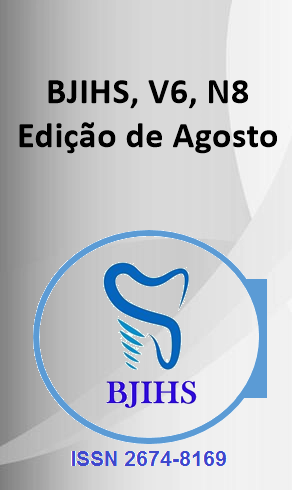Resumo
Acidente Vascular Encefálico (AVE) é um termo abrangente utilizado para descrever uma condição patológica resultante de uma interrupção súbita do fluxo sanguíneo cerebral, que compromete a perfusão adequada dos tecidos encefálicos. Ambos os tipos de AVE têm como consequência a alteração das funções neurológicas, que se manifesta clinicamente por déficits motores, sensoriais, cognitivos e de linguagem, dependendo da localização e da extensão da lesão cerebral. Sendo assim, é importante compreender como é feito o manejo dos pacientes que são acometidos por AVE isquêmico e hemorrágico, a fim de avaliar o processo de condutas, bem como a observação de novas medicações. Trata-se de uma revisão sistemática da literatura, a qual investigou sobre o manejo do AVE no pronto socorro, pela coleta de dados nas plataformas PubMed, LILACS, Periódicos CAPES, EMBASE e Scielo, dos últimos 5 anos. Assim, a evidência sugere que o timing da anticoagulação deve ser cuidadosamente considerado, especialmente em pacientes com transformação hemorrágica. Estudos futuros são necessários para aprofundar a compreensão dos efeitos a longo prazo desses tratamentos, otimizar o gerenciamento de hemorragias associadas e estabelecer diretrizes mais precisas para o manejo do AVE isquêmico agudo. A investigação adicional deve focar em subgrupos de pacientes, possíveis combinações terapêuticas e ajustes na janela de tratamento para melhorar os resultados funcionais e a segurança do paciente.
Referências
AGUIRRE, A. O. et al. Stroke management and outcomes in low-income and lower-middle-income countries: a meta-analysis of 8535 patients. Journal of neurosurgery, v. 139, n. 4, p. 1042–1051, 1 out. 2023.
ALBERS, G. W. et al. Tenecteplase for Stroke at 4.5 to 24 Hours with Perfusion-Imaging Selection. New England Journal of Medicine, v. 390, n. 8, p. 701–711, 22 fev. 2024.
BENESCH, C. et al. Perioperative Neurological Evaluation and Management to Lower the Risk of Acute Stroke in Patients Undergoing Noncardiac, Nonneurological Surgery: A Scientific Statement From the American Heart Association/American Stroke Association. Circulation, v. 143, n. 19, 11 maio 2021.
FIELD, T. S. et al. Embolic Stroke of Undetermined Source: Current Perspectives on Diagnosis, Investigations, and Management. Canadian Journal of Cardiology, v. 39, n. 2, p. 172–186, 1 fev. 2023.
HADANNY, A. et al. Hyperbaric oxygen therapy improves neurocognitive functions of post-stroke patients – a retrospective analysis. Restorative Neurology and Neuroscience, v. 38, n. 1, p. 93–107, 11 fev. 2020.
HUO, X. et al. Trial of Endovascular Therapy for Acute Ischemic Stroke with Large Infarct. New England Journal of Medicine, v. 388, n. 14, p. 1272–1283, 6 abr. 2023.
LEE, E. C. et al. Utility of Exosomes in Ischemic and Hemorrhagic Stroke Diagnosis and Treatment. International Journal of Molecular Sciences, v. 23, n. 15, p. 8367–8367, 28 jul. 2022.
LI, S. et al. Reteplase versus Alteplase for Acute Ischemic Stroke. New England Journal of Medicine, v. 390, n. 24, p. 2264–2273, 27 jun. 2024.
MARZOLINI, S. Including Patients With Stroke in Cardiac Rehabilitation. Journal of Cardiopulmonary Rehabilitation and Prevention, v. 40, n. 5, p. 294–301, 1 set. 2020.
NTAIOS, G. Embolic Stroke of Undetermined Source. Journal of the American College of Cardiology, v. 75, n. 3, p. 333–340, 1 jan. 2020.
PERERA, K. S. et al. Evaluating Rates of Recurrent Ischemic Stroke Among Young Adults With Embolic Stroke of Undetermined Source. JAMA Neurology, v. 79, n. 5, p. 450–450, 1 maio 2022.
ROHNER, R. et al. Early Versus Late Initiation of Direct Oral Anticoagulants After Ischemic Stroke in People With Atrial Fibrillation and Hemorrhagic Transformation: Prespecified Subanalysis of the Randomized-controlled ELAN Trial. Circulation, v. 150, n. 1, p. 19–29, 2 jul. 2024.
SHUAI, J. et al. Effect of Intravenous Tirofiban vs Placebo Before Endovascular Thrombectomy on Functional Outcomes in Large Vessel Occlusion Stroke. JAMA, v. 328, n. 6, p. 543–543, 9 ago. 2022.
YANG, Y. et al. The impact of triglyceride-glucose index on ischemic stroke: a systematic review and meta-analysis. Cardiovascular Diabetology, v. 22, n. 1, 6 jan. 2023.
ZHAO, Y. et al. Neuronal injuries in cerebral infarction and ischemic stroke: From mechanisms to treatment (Review). International Journal of Molecular Medicine, v. 49, n. 2, 8 dez. 2021.

Este trabalho está licenciado sob uma licença Creative Commons Attribution 4.0 International License.
Copyright (c) 2024 Thatiana Simão de Oliveira, Marcos Martinelle Dionizio Almeida, Ramiely Castro Paulino, Thatiely Castro Paulino, Isabela Christina Silva Nogueira, Karina Kirmse, Hugo Sanchez Gomes, Júlia Nascimento Legatti, Isabela Ceccato de Sousa, Idna Maria Fernandes Silveira Martins, Luanna Dornelas Rodrigues Couto, Juliana Beatriz Espindula Raizel, Anna Beatriz Correa Casagrande
